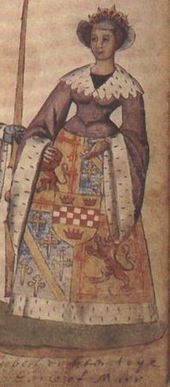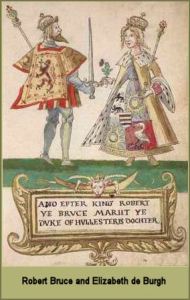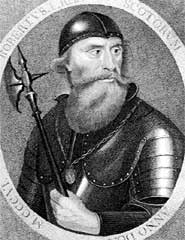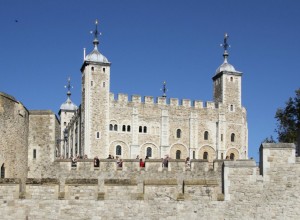Certain periods and people in history hold a particular fascination for me. Robert the Bruce is one such. The grandfather of the Stewart dynasty and hero of Scotland, he started his career with some very divided loyalties. Initially a supporter of Edward I, it was only the arrival of William Wallace that started Bruce on his journey to becoming the saviour of Scottish independence.
Through the murder of his greatest rival and the Battle of Bannockburn, Bruce proved himself determined and resourceful, overcoming defeat to emerge victorious and master of his realm.
Bruce suffered greatly for the crown, with his family and friends facing similar hardships.
Robert the Bruce’s wife endured a no less punishing life in support of her husband.
Elizabeth de Burgh was born around 1289. The daughter of Richard de Burgh, Earl of Ulster and Connaught, and his wife, Margaret, she was a god-daughter of England’s king, Edward I. At the age of 13 Elizabeth was married to Robert the Bruce, Earl of Carrick, in 1302; probably at his manor of Writtle, near Chelmsford in Essex. It is possible the marriage was arranged by Edward; he certainly encouraged it, as a way of keeping his young Scottish noble loyal to his cause.

However, events in Scotland would soon push the Bruce away from his English alliances; his murder of his greatest rival for the throne, John Comyn, in the Chapel of the Greyfriars in Dumfries. Aware that he would be excommunicated for his actions, Bruce raced to Scone to be crowned before a papal bull could be issued.
6 weeks later, on March 25th 1306, the Bruce was crowned King Robert I of Scotland, with Elizabeth by his side, by Isabella MacDuff, Countess of Buchan. As daughter of the Earl of Fife, Isabella claimed the hereditary right of the Clan MacDuff, to crown the King of Scots. The couple was crowned in a second ceremony the next day by the Bishop of St Andrews, William Lamberton, who had arrived too late to play his part in the ceremony on the 25th.
Unfortunately the coronation was not the end of trouble for the Bruces. If anything, things were about to get much worse.
An ailing Edward I sent his loyal lieutenant, Aymer de Valence, north and he met and defeated Robert’s army at Methven in June of the same year. Robert sent his brother Neil and the Earl of Atholl to escort his wife to safety. They took the Queen, Princess Marjorie (Robert the Bruce’s daughter by his first marriage), sisters Mary and Christian and the countess of Buchan, north towards Orkney.
However, the English caught up with them at Kildrummy Castle and laid siege to it. The garrison was betrayed from within, the barns set alight and the Bruce women had barely time to escape with the Earl of Atholl before the castle was taken. Sir Neil Bruce and the entire garrison were executed; Neil was hung, drawn and quartered at Berwick in September 1306.
Queen Elizabeth and her companions made for Tain, in Easter Ross, possibly in the hope of finding a boat to take them onwards. However, they were captured by the Earl of Ross (a former adherent of the deposed King John Balliol), who took them from sanctuary at St Duthac and handed them over to the English. They were sent south, To Edward I at Lanercost Priory.
Elizabeth’s capture would have been a hard blow for Robert the Bruce. The new King of Scotland still lacked a male heir, and had no chance of getting one while his wife was in English hands. This made his hold on the throne even more precarious than it already was.
Edward I’s admirer, Sir Maurice Powicke said Edward treated his captives with a ‘peculiar ferocity’. He ordered that 24-year-old Mary Bruce and Isabella, the Countess of Buchan who performed Robert the Bruce’s coronation, should be imprisoned in specially constructed iron cages and suspended from the outside walls of castles; Mary at Roxburgh and Isabella at Berwick. Although it is more likely that the cages were in rooms within the castles, rather than exposed to the elements, they would be held in that way for 4 years, until Edward I’s successor, Edward II, ordered their removal to convents in 1310.
It seems Edward ordered a cage to be made Marjorie at the Tower of London, where she was first held. But he relented, possibly because of her age, and the child – not yet 12 years old – was sent to a nunnery in Yorkshire. Initial orders were given that she should be held in solitary confinement, with no one allowed to speak to her; but this may also have been rescinded.
Marjorie’s aunt and Mary’s older sister, Christian, was also sent to a Gilbertine nunnery, this time in Lincolnshire; although her husband, Sir Christopher Seton, was hung, drawn and beheaded at Dumfries.
Elizabeth was treated more kindly than her step-daughter, and the other ladies. Her father was a close ally of Edward I and the king did not want to alienate him. The Queen of Scots was sent to Burstwick Manor in Holderness, Yorkshire, from where she wrote to Edward I, in an undated letter, complaining that she only had 3 changes of clothes, and no bed linen. She then spent 4 years at Bisham Manor in Berkshire.
However in 1312, with her husband gaining strength and raiding into Yorkshire, she was moved to a more secure location, probably the Tower of London (although some sources state Windsor Castle). By this time she was allowed 6 attendants and was given a regular allowance.Elizabeth was later moved to Shaftesbury Abbey in Dorset but the political situation was about to change.
In 1314 Robert the Bruce achieved a not inconsiderable victory at the Battle of Bannockburn over Edward II and his English forces. Several notable English lords were taken prisoner, including Humphrey de Bohun, Earl of Hereford. Negotiations for his release led to a prisoner exchange and Elizabeth and the rest of the Bruce ladies, finally returned to Scotland after 8 years of imprisonment.
Reunited at last, Robert set about consolidating his kingdom, with his queen at his side.
His daughter, Marjorie Bruce, was married to Walter Stewart, hereditary High Steward of Scotland. Following a fall from a horse while heavily pregnant, she gave birth to King Robert’s first grandson, also named Robert and the future king Robert II. Marjorie died just a few hours later.

Between 1315 and 1323 Elizabeth and Robert had two daughters: Margaret married William, 5th Earl of Sutherland and died in childbirth in 1346 or 1347; Matilda married Thomas Isaac and had two daughters, she died in 1353.
The much longed-for son, David, was born in 1324; he was married to Joan of the Tower, daughter of Edward II of England, in 1328 and would succeed his father at the age of 5, as King David II, in 1329.
A second son, John, was born in 1327 but died young.
Elizabeth herself died on the 27th of October 1327, aged around 38, at the royal residence at Cullen in Banffshire. Given that her younger son was born – and died – in the same year as Elizabeth’s death, complications in childbirth, or in her recovery from childbirth, could well have contributed to Elizabeth’s death. The queen was buried in Dunfermline Abbey; Robert the Bruce was buried beside her when he died 18 months later.
*
Pictures courtesy of Wikipedia.
*
Sources:
The Story of Scotland by Nigel Tranter; Brewer’s British Royalty by David Williamson; Kings & Queens of Britain by Joyce Marlow; Mammoth Book of British Kings & Queens by Mike Ashley; Oxford Companion to British History Edited by John Cannon; Edward I A Great and Terrible King by Marc Morris; Britain’s Royal Families by Alison Weir; berkshirehistory.com; englishmonarchs.co.uk; thefreelancehistorywriter.com; berkshirehistory.com; educationscotland.gov.uk/scotlandhistory.
*
My Books:
Signed, dedicated copies of all my books are available through my online bookshop.
Coming 15 January 2024: Women of the Anarchy
On the one side is Empress Matilda, or Maud. The sole surviving legitimate child of Henry I, she is fighting for her birthright and that of her children. On the other side is her cousin, Queen Matilda, supporting her husband, King Stephen, and fighting to see her own son inherit the English crown. Both women are granddaughters of St Margaret, Queen of Scotland and descendants of Alfred the Great of Wessex. Women of the Anarchy demonstrates how these women, unable to wield a sword, were prime movers in this time of conflict and lawlessness. It show how their strengths, weaknesses, and personal ambitions swung the fortunes of war one way – and then the other.
Available for pre-order from Amberley Publishing and Amazon UK.
Also by Sharon Bennett Connolly:
Out now: King John’s Right-Hand Lady: The Story of Nicholaa de la Haye is the story of a truly remarkable lady. Nicholaa de la Haye was the hereditary constable of Lincoln Castle and the first woman in England to be appointed sheriff in her own right. Her strength and tenacity saved England at one of the lowest points in its history. Nicholaa de la Haye is one woman in English history whose story needs to be told…
King John’s Right-Hand Lady: The Story of Nicholaa de la Haye is now available from Pen & Sword Books, bookshop.org and Amazon.
Defenders of the Norman Crown: The Rise and Fall of the Warenne Earls of Surrey tells the fascinating story of the Warenne dynasty, of the successes and failures of one of the most powerful families in England, from its origins in Normandy, through the Conquest, Magna Carta, the wars and marriages that led to its ultimate demise in the reign of Edward III. Defenders of the Norman Crown: Rise and Fall of the Warenne Earls of Surrey is now available from Pen & Sword Books, Amazon in the UK and US, and Bookshop.org.
Ladies of Magna Carta: Women of Influence in Thirteenth Century England looks into the relationships of the various noble families of the 13th century, and how they were affected by the Barons’ Wars, Magna Carta and its aftermath; the bonds that were formed and those that were broken. It is now available in paperback and hardback from Pen & Sword, Amazon, and Bookshop.org.
Heroines of the Medieval World tells the stories of some of the most remarkable women from Medieval history, from Eleanor of Aquitaine to Julian of Norwich. Available now from Amberley Publishing and Amazon, and Bookshop.org.
Silk and the Sword: The Women of the Norman Conquest traces the fortunes of the women who had a significant role to play in the momentous events of 1066. Available now from Amazon, Amberley Publishing, and Bookshop.org.
Alternate Endings: An anthology of historical fiction short stories including Long Live the King… which is my take what might have happened had King John not died in October 1216. Available in paperback and kindle from Amazon.
Podcast:
Have a listen to the A Slice of Medieval podcast, which I co-host with Historical fiction novelist Derek Birks. Derek and I welcome guests, such as Bernard Cornwell, and discuss a wide range of topics in medieval history, from significant events to the personalities involved.
*
Don’t forget! Signed and dedicated copies of all my books are available through my online bookshop.
For forthcoming online and in-person talks, please check out my Events Page.
You can be the first to read new articles by clicking the ‘Follow’ button, liking our Facebook page or joining me on Twitter and Instagram.
*
©2015 Sharon Bennett Connolly FRHistS








The “Bruce” is my ancestor .
LikeLike
That’s great, Jean. How wonderful.
LikeLike
Reblogged this on evelynralph and commented:
Loads here that I had no idea about. Very interesting indeed.
Evelyn.
LikeLike
Thank you Evelyn, I really appreciate it. Best wishes. 🙂
LikeLike
A fascinating post. It’s incredible to realise the life these women lived – four years in cages!
LikeLike
Thank you Carol. I find it incredible that anyone – let alone a king – could be so vicious and cruel. 😦
LikeLike
Researching this line was exhausting, but found out that I have a direct line to the Robert The Bruce. Fascinating history lessons learned here! Thank you for sharing your wealth of knowledge
LikeLike
Thank you, Catherine, I’m really glad you found it interesting. ☺
LikeLike
Reblogged this on History's Untold Treasures and commented:
H/T History … the Interesting Bits!
LikeLike
Thank you Meghan ☺
LikeLike
“Although it is more likely that the cages were in rooms within the castles, rather than exposed to the elements”
What is your basis for this statement? Is there some historical record that indicates this or is it that you just don’t believe Edward I could be that cruel?
LikeLike
Hi Lisa, i believe Edward I was perfectly capable of hanging women in cages from castle walls, but it didn’t happen in this case. The writ of 1306 overseeing the construction of the cage and imprisonment of Countess Buchan specifies that the cage is to be built within one of the turrets of the keep. Which is also what Edward did with the sons of David, the last Prince of Wales at Bristol Castle. The idea of the cages being suspended from the castle walls was a misreading of the writ – or maybe someone wanting to make Edward it to be even worse than he was. Good that clarifies it? Regards, Sharon
LikeLike
Fascinating post. I have recently relocated to Scotland and this has sparked an interest in Scottish history. I actually found this post as I googled Elizabeth de Burgh after watching Outlaw/King on Netflix. I thought her story was fascinating but underplayed in the movie. Great blog, looking forward to browsing the rest of your posts.
LikeLike
Thanks so much. I was so disappointed with the portrayal of the Bruce women in Outlaw King. I thought they missed an opportunity to show how vital they all were – his wife and sisters – to the story. Best wishes, Sharon
LikeLike
I also watched the “Outlaw King”. I’m a bit of a history buff and, just lately, learned I am almost 100% English, Scottish, and Irish. I agree with you regarding “The Outlaw King”. Obviously, it was written by males with a hearty amount of blood and gor and little about the females of that time! I truly enjoyed your story!
LikeLike
Thank you Paulette. I do think it’s a shame they didn’t tell more of the women’s stories – they missed a big opportunity. But, hey ho, its a film not a documentary. And a lot of people have researched the true story, since – which is always a bonus. Best wishes, Sharon
LikeLike
Interesting
LikeLiked by 1 person
Thank you Robert 😀
LikeLike